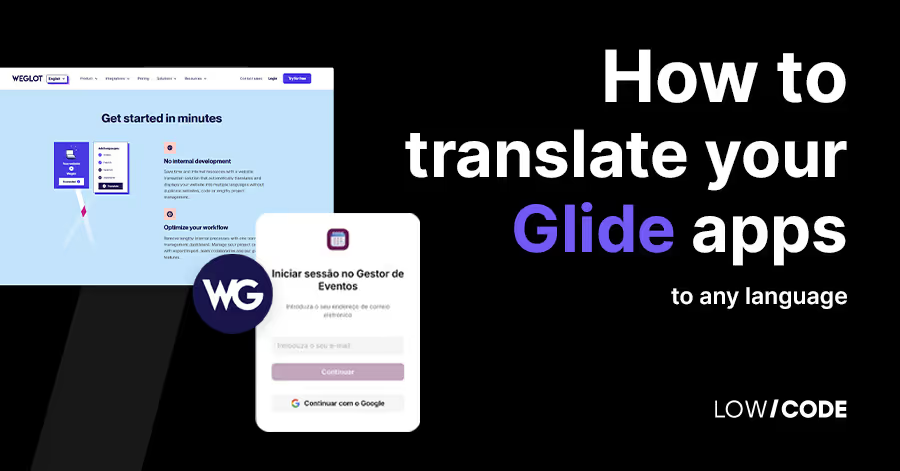Top Glide alternatives for no-code app development in 2025
9 min
read
Explore top no-code alternatives to Glide like FlutterFlow, Bubble, Adalo, and Softr. Find the best platform for your project.

Glide is a popular no-code platform that enables users to build mobile and web applications. Glide’s core functionalities include real-time data updates, seamless integration with Google Sheets, and an intuitive drag-and-drop interface for building user interfaces and workflows. It's an attractive option for those looking to quickly deploy data-driven applications without writing any code.
The purpose of this article is to explore alternatives to Glide, addressing common pain points users might experience with no-code platforms. We want to help you make an informed decision based on your specific project needs and requirements. We'll guide you through assessing your needs and contrasting them with the options available. Do you need advanced customization? The best performance? Maybe you need to handle lots of data, or you want to focus on user experience. This article will guide you through the options available.
Let's get started!
Why look for alternatives?
When working on a no-code project, it's essential to have a platform that aligns with your needs and goals. While Glide is a popular choice, some users may have concerns about it being suitable for their project.
Here are some considerations that might lead you to look for alternatives:
- Pricing concerns: Glide offers a free plan, but it comes with limitations that may not fit your project's requirements. As your application grows and gains more users, the costs associated with premium plans could become a significant problem.
- Feature limitations: While Glide provides a robust set of features, some users may find that it lacks some specific functionalities they need.
- Learning curve: Despite being a no-code platform, Glide still requires a learning curve to master its interface, logic, and capabilities. If you’re thinking of taking on the project yourself, without hiring Glide experts, the learning process can be time-consuming, especially for those new to development or with limited technical backgrounds.
- Scalability concerns: As your application gains traction and attracts more users, you need to upgrade and scale. Glide's scalability options may not align with your project's growth trajectory, leading to performance issues or data management challenges.
- Vendor lock-in: Committing to a specific no-code platform can create a dependency that may be difficult to break free from in the future. If your project's requirements evolve significantly or if you encounter issues with the platform, transitioning to another solution could be complicated and resource-intensive.
Top Glide alternatives
Bubble

Bubble excels in several key areas, and it's an attractive choice for complex projects. One of its primary strengths is database and backend management. In simple terms, the backend refers to the server side of an application where data is stored and processed. Bubble allows users to create and manage these data structures and workflows directly within the platform, so it's easier to handle all the complex data operations an app requires.
Another significant advantage of Bubble is its extensive plugin ecosystem. Plugins are additional pieces of software that can be integrated into your app to extend its functionality. For instance, you might use a plugin to add payment processing, integrate social media features, or enhance the app's analytics capabilities. Bubble's marketplace offers a wide variety of these plugins and allows users to add advanced features without writing custom code.
Bubble is also designed with scalability in mind. For projects that anticipate significant growth, Bubble provides the infrastructure to support this expansion smoothly, without compromising performance.
While Bubble's pricing model includes several tiers, it offers plans that can suit different budgets. For users with more complex needs, the ability to integrate advanced features and manage extensive data within one platform can make Bubble a cost-effective choice in the long run.
Differences between Bubble and Glide
Glide is ideal for quick, straightforward solutions and data-driven applications due to its user-friendly interface. It's also reliable and can handle large amounts of data. However, it may fall short for projects that require more intricate custom workflows and designs.
Bubble has a steeper learning curve than Glide, but it provides extensive resources to help users get up to speed. This includes detailed documentation, step-by-step tutorials, and an active community forum where users can seek advice and share insights. The initial investment in learning Bubble can pay off since it lets you create more sophisticated applications.
- Related: Bubble vs Glide
- Related: Bubble.io capabilities and limitations
FlutterFlow

Another strong alternative to Glide is FlutterFlow, a platform designed to facilitate the development of native mobile apps.
FlutterFlow is built on Google's Flutter framework, which is designed for building natively compiled applications for mobile, web, and desktop from a single codebase. This means that apps developed with FlutterFlow can be deployed as both native mobile apps and PWAs. Native apps built with FlutterFlow can take full advantage of the device's hardware and software capabilities, such as camera access, push notifications, and offline functionality.
Another significant feature of FlutterFlow is its code export functionality. Users can export the underlying Flutter code of their applications, so they can further customize the app using traditional coding methods if needed. Also, keep in mind that you can get the Flutter code of your app at any point of development and keep developing your app outside the FlutterFlow environment. You don't have to worry about vendor lock-in.
Differences between FlutterFlow and Glide
One key difference between FlutterFlow and Glide is their focus on application types. FlutterFlow leverages Flutter to build native mobile apps for iOS and Android. In contrast, Glide specializes in creating PWAs, responsive web applications that work seamlessly across devices and operating systems.
While FlutterFlow offers more control for native apps, Glide delivers highly responsive experiences out of the box. The platform is optimized for building apps that adapt flawlessly to different screen sizes and devices. Achieving the same level of responsiveness can be more challenging with FlutterFlow's mobile-first approach, especially for desktop environments.
- Related: Glide vs Flutterflow
- Related: FlutterFlow review
- Related: FlutterFlow pros and cons
Adalo

Adalo is another noteworthy alternative to Glide. One of Adalo's key strengths is its ability to create both native mobile and web applications. Users can build apps that run on both iOS and Android devices as well as web browsers.
Adalo users can also manage data and automate processes. It also has a complete marketplace of pre-built components and templates. These components can be easily integrated into apps, speeding up the development process.
Adalo's intuitive drag-and-drop interface significantly reduces the learning curve, making it easy for beginners to start building apps quickly. Additionally, Adalo provides extensive tutorials, documentation, and community support to help users navigate the platform and make the most of its features.
Differences between Adalo and Glide
Adalo and Glide both aim to simplify the app development process, but they cater to slightly different needs and project scopes. Glide is well-suited for creating sophisticated applications that go beyond simple data presentation. It supports various data sources like Google Sheets, BigQuery, and SQL, making it a robust platform for developing interconnected app systems.
Adalo, on the other hand, offers more extensive capabilities for building mobile applications. It provides a broad range of functionalities through its extensive marketplace of pre-built components and templates, allowing users to add custom forms, payments, user authentication, and more.
- Related: Glide vs Adalo
Softr

Softr is another excellent alternative to Glide, particularly suited for users looking to create web applications. Softr allows users to build web applications directly from Airtable, a popular database tool.
A key strength of Softr is its extensive collection of templates and pre-built blocks. These templates cover a wide range of use cases, such as membership sites, marketplaces, and dashboards, allowing users to get started quickly. The pre-built blocks can be easily customized to fit specific needs.
Common pain points
- Features: Softr addresses the feature limitations some users experience with Glide by offering a robust set of tools tailored for web application development. Its tight integration with Airtable allows users to leverage their existing data effectively, while the customizable templates and blocks provide flexibility for different project requirements.
- Learning Curve: The learning curve for Softr is relatively shallow due to its intuitive interface and drag-and-drop functionality. Additionally, Softr provides comprehensive tutorials, documentation, and community support, making it easy for users to get started and build their applications quickly.
Differences between Softr and Glide
Softr relies heavily on its integration with Airtable. While this integration can be advantageous for users already utilizing Airtable, it can be limiting for those who need more flexibility in their data sources. Glide’s support for multiple data sources gives it a significant edge in versatility and adaptability.
Another key difference is Softr's focus on providing a variety of templates and pre-built blocks, which allows users to quickly create and customize web applications. However, this reliance on templates can sometimes result in less flexibility for advanced customizations compared to Glide's capabilities.
In terms of scalability, Glide’s ability to handle more complex applications and integrate seamlessly with various data sources makes it a more powerful platform for businesses and teams looking to develop sophisticated and interconnected app systems. Softr’s approach, while user-friendly, might not offer the same level of depth and flexibility needed for more demanding projects.
- Related: Glide vs Softr
A quick guide on choosing the right alternative
When deciding on the best alternative to Glide, it's essential to consider your unique needs and project requirements. Each platform offers distinct strengths and features. Here are some key factors to help you make an informed decision:
- Identify your project goals: Clearly outline what you want to achieve with your app. Are you building a mobile app, a web app, or both? Do you need specific features like user authentication, payment processing, or real-time updates?
- Determine your budget: Establish how much you are willing to spend on the app development platform. Consider both initial costs and potential future expenses.
Evaluate the complexity
Understand the complexity of your project. Is it a simple data presentation tool, a medium-complexity app with multiple user interactions, or a highly complex application with advanced workflows and integrations?
Match complexity to platforms:
- For highly complex projects, consider platforms like Bubble that offer extensive customization and backend capabilities.
- For medium-complexity projects, Adalo provides a good balance of ease of use and powerful features.
- For complex, data-driven web apps, Glide is ideal, and Softr is another suitable choice.
List required features
Make a list of all the features your app needs, such as database management, user authentication, mobile-specific functionalities, or specific integrations.
Compare features:
- Bubble: Comprehensive feature set, suitable for complex workflows and extensive customizations.
- FlutterFlow: Focuses on high-performance native apps and PWAs, ideal for advanced mobile features.
- Adalo: Offers versatile pre-built components, perfect for adding custom forms, payments, and user authentication.
- Softr: Leverages Airtable for data management, providing a wide array of customizable templates for quick web app development.
- Glide: Great for creating mobile and web apps that are data-driven, with strong capabilities in real-time data updates and easy integration with various data sources.
Consider ease of use and learning curve: Determine the technical expertise of your team. Are they familiar with coding, or do they prefer a no-code environment?
Based on ease of use:
- Bubble: Offers powerful features but may have a steeper learning curve due to its extensive capabilities.
- FlutterFlow: Provides a visual interface with the option to export and customize code, balancing ease of use and advanced functionality.
- Adalo: User-friendly with a straightforward drag-and-drop interface, suitable for beginners.
- Softr: Highly intuitive and easy to use, especially for those already familiar with Airtable.
- Glide: Known for its simple interface and ease of integration with multiple data sources.
Optional: Test the platforms
Take advantage of free trials or demo versions of the platforms. This hands-on experience will help you understand which platform best suits your needs. If possible, build a small prototype or a basic version of your app on each platform. You’ll get a better idea of the development process and the platform’s capabilities.
- Related: The cost of no-code app development
- Related: Top Glide use case
Final thoughts
No-code platforms offer powerful capabilities, but selecting the right one requires careful evaluation. Consider your budget, the complexity of your project, the feature set you need, scalability, security needs, vendor lock-in risks, and third-party ecosystem. Most importantly, ensure the platform's feature set matches your app's complexity and requirements.
Evaluate all the factors, consult with experts, and compare your options to select the most suitable platform to bring your project to life. Don't be afraid to try out free trials, speak to experts, and thoroughly test a few different options.
While selecting the right platform requires careful evaluation, the core value of no-code solutions is undeniable. With some research, you can find the perfect no-code solution to turn your app idea into reality.
As a leading Glide agency, we're ready to guide you through the entire process of building your project.
If you want to delve deeper into this topic, we recommend reading our article on The cost of no-code app development in 2025. Or book a free discovery call. We'll help you pick (for free) the best platform for your project.
Created on
May 26, 2024
. Last updated on
May 7, 2025
.

FAQs
Is FlutterFlow better than Glide?
How does Softr compare to Glide?
If I choose a no-code platform, should I worry about vendor lock-in?
What should I look for in a no-code platform?







%20(Custom).avif)








